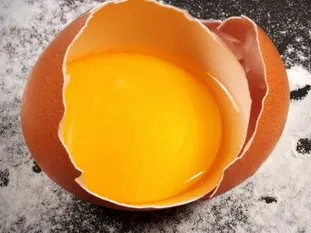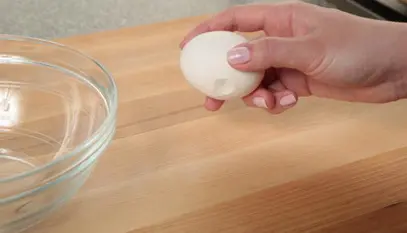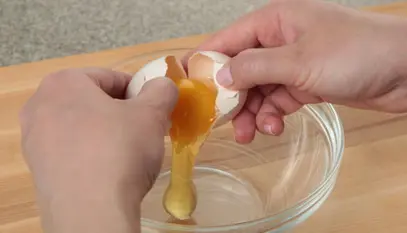This site uses only a few technical cookies necessary for its operation. By continuing to browse, you accept their use.
To find out more...
To find out more...
How to break eggs properly?

It is a very common gesture in pastry, bakery and of course cooking: breaking eggs to incorporate them into a recipe.
You have eggs (which professionals call "shell eggs" to differentiate them from liquid eggs in cartons or cans), and you must break them to incorporate the contents into your recipe and discard the shell.
It's not rocket science, you crack the shell, push it aside to drop the egg into the bowl/container, and discard the shell.
No difficulty, but a point to note anyway, to crack the egg you may do as your mum or dad taught you when you were a child, that is to say that you crack the egg using the edge of the bowl to break the shell.
A natural enough gesture, but not at all effective...
You have eggs (which professionals call "shell eggs" to differentiate them from liquid eggs in cartons or cans), and you must break them to incorporate the contents into your recipe and discard the shell.
It's not rocket science, you crack the shell, push it aside to drop the egg into the bowl/container, and discard the shell.
No difficulty, but a point to note anyway, to crack the egg you may do as your mum or dad taught you when you were a child, that is to say that you crack the egg using the edge of the bowl to break the shell.
A natural enough gesture, but not at all effective...
15 K 4.8/5 (16 reviews)
Keywords for this post:EggBreakTipTrickMethodLast modified on: June 26th 2021
How to break eggs properly?
Why?
First of all, because by doing this you'll get a lot of egg white on the inside and outside edges of your bowl that you'll have to pick up/clean afterwards.Secondly, you have to be careful with the hygiene of the eggs, they come out of a hen's ass (no scoop) and unfortunately a hen's intestine can contain salmonella, bacteria that are sometimes present on the outside of the shell and can pass from your bowl into your recipe, and risk making you sick.
Well, you shouldn't be paranoid about this either, the shells of eggs from the agro-industry are washed before they land on the shelf, you just have to be a little more careful with eggs from your henhouse, or those bought at the market directly from the small producer.
And then if your recipe goes into the oven afterwards, no more risks, but for a mayonnaise for example it's trickier.
All this to say that it is better, if possible, to avoid contact of the eggshell with your preparation in progress, and that therefore this way of splitting the eggs on the edge of the salad bowl is not great.
How do you do it then?
It's very simple, tap the egg on the surface of your work surface, a short sharp tap to start breaking the shell.
Bring the pre-cracked egg to the top of your bowl, and finish breaking the shell by dipping your thumbs inside, and pulling it apart to let the egg fall into the bowl.

Throw away the shell, move on to the next egg.
With this way you are sure to make, no shell/bowl/preparation contact.
To sum up: To break eggs into a preparation, don't knock on the edge of the bowl, but rather on the work surface.
Lasts posts
Butter vs. grease
We often read in a recipe where a pastry is put into a mould that, just before pouring, the mould should be buttered or greased. But what's the difference between these 2 terms?December 1st 20256975
Getting out of the fridge early
Very often when you're cooking, you need to take food or preparations out of the fridge, to use them in the recipe in progress. There's nothing tricky about this: you just take them out of the fridge and use them, usually immediately, in the recipe. But is this really a good method?November 24th 20259735
Who's making the croissants?
When you look at a bakery from the outside, you naturally think that in the bakery, the bakers make the bread, and in the laboratory, the pastry chefs make the cakes. It's very often like that, with each of these professions having quite different ways of working, but sometimes there's also one...November 23th 2025872
Oven height
When we put a dish or cake in the oven, we naturally tend to put it on the middle shelf, and that's what we usually do. But in some cases, this position and height can be a little tricky, so let's find out why.October 8th 20252,4805
The importance of sieving
In recipes that use a fine powder (flour, powdered sugar, etc.), you'll often see the advice to sift before using it. To sift is to pass the powder in question through a sieve (a very fine strainer) before incorporating it into your recipe. It's often advice, but is it really useful?September 3rd 20257,3583
Other pages you may also like
Well-cooked meat
Have you ever noticed that if you like your meat well done, it invites strange looks? For instance, in a restaurant, when asked “How would you like that cooked?” If you reply, “Well done,” it is almost as if you are swearing….May 21th 201134 K 14.4
Cooking time for pasta
What is as good and simple as pasta? Not much, I think, and it's so easy to prepare: boiling water, salted (or not, depending on your taste), a few minutes of boiling and it's ready. The only "difficulty", so to speak, is the respect of the cooking time and the risk of, unfortunately, overcooking...July 18th 201923 K4.6
Different kinds of pastry and dough
When cooking in general, and particularly in baking, we can make and use many different kinds of pastry and dough. All built on the same "base": flour - a powder to which we add fat, liquid or both to produce the dough which is then cooked. .November 6th 2012111 K 14.0
Candied fruits: don't get ripped off
Do you like candied fruit? You might like to nibble a handful or add it to a recipe, like a classic fruit cake or delicious Italian specialities like panettone or sicilian epiphany pie.June 21th 201767 K 24.2
The march forward
When professionals get to work in their kitchen, lab or bakery, they are (if they are conscientious) very sensitive to hygiene and cleanliness. It is impossible for a good baker for example to do a day's work without regularly cleaning the table where he or she works, and it is even more...June 30th 202120 K5
Post a comment or question
Follow this page
If you are interested in this page, you can "follow" it, by entering your email address here. You will then receive a notification immediately each time the page is modified or a new comment is added. Please note that you will need to confirm this following.
Note: We'll never share your e-mail address with anyone else.
Alternatively: you can subscribe to the mailing list of cooling-ez.com , you will receive a e-mail for each new recipe published on the site.









